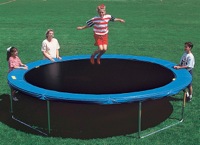Difference between revisions of "Trampoline"
(Created page with 'File:lighterstill.jpgright|frame ==Origin== Italian ''trampolino'' springboard, from ''trampoli'' stilts, of Germanic origin; akin to Middle Lo...') |
m (Text replacement - "http://" to "https://") |
||
| Line 3: | Line 3: | ||
==Origin== | ==Origin== | ||
Italian ''trampolino'' springboard, from ''trampoli'' stilts, of Germanic origin; akin to Middle Low German ''trampen'' to stamp | Italian ''trampolino'' springboard, from ''trampoli'' stilts, of Germanic origin; akin to Middle Low German ''trampen'' to stamp | ||
| − | *[ | + | *[https://en.wikipedia.org/wiki/18th_century 1798] |
==Definitions== | ==Definitions== | ||
| − | *1: a resilient sheet or web (as of nylon) [[supported]] by springs in a metal frame and used as a springboard and landing area in [ | + | *1: a resilient sheet or web (as of nylon) [[supported]] by springs in a metal frame and used as a springboard and landing area in [https://en.wikipedia.org/wiki/Tumbling_%28gymnastics%29 tumbling] |
==Description== | ==Description== | ||
A '''trampoline''' is a device consisting of a piece of taut, strong [[fabric]] stretched over a steel frame using many coiled springs. People bounce on trampolines for recreational and [[competitive]] [[purposes]]. | A '''trampoline''' is a device consisting of a piece of taut, strong [[fabric]] stretched over a steel frame using many coiled springs. People bounce on trampolines for recreational and [[competitive]] [[purposes]]. | ||
Latest revision as of 02:41, 13 December 2020
Origin
Italian trampolino springboard, from trampoli stilts, of Germanic origin; akin to Middle Low German trampen to stamp
Definitions
- 1: a resilient sheet or web (as of nylon) supported by springs in a metal frame and used as a springboard and landing area in tumbling
Description
A trampoline is a device consisting of a piece of taut, strong fabric stretched over a steel frame using many coiled springs. People bounce on trampolines for recreational and competitive purposes.
The fabric that users bounce on (commonly known as the 'bounce mat' or 'trampoline bed') is not elastic in itself; the elasticity is provided by the springs that connect it to the frame, which store potential energy.
Trampolining is an individual sport of acrobatic movements performed after rebounding into the air from the trampoline. As a competitive sport, it was included in the Pan-American Games for the first time in 1955, and a world championship was established in 1964; competitors are scored on difficulty, execution, and form.
